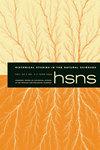Making Animal Materials in Time
IF 0.3
3区 哲学
Q2 HISTORY & PHILOSOPHY OF SCIENCE
引用次数: 0
Abstract
This special issue, “Making Animal Materials in Time,” delves into the history of animal materials used in craft and scientific endeavors since the eighteenth century. We regard animal materials as dynamic elements with particular properties granted context-specific and culturally fluid meanings by those who work with them—often to the point of dissolving their original animal materiality. Focusing on this multi-dynamic at the intersection of history of science and the anthropology of techniques permits a reformulation of the concept of affordance, as material affordances, to create the theoretical capacity for a discussion of the diverse processes of rendering animal bodies into new substances, materials, and things. Six case studies illustrate how human historical actors distinguished animal materials as they observed, envisioned, extracted, processed, and changed animal bodies and tissues into new elements. Collectively, these papers present a strategy for examining connections between the spatial and temporal qualities of animal materials situated in human-scale material practices. The animal materials featured in this special issue serve as boundary objects across practical settings, contexts, regions, and cultural world settings that instrumentally link the history of science to anthropologies of craft knowledges.及时制作动物材料
本期特刊“及时制作动物材料”深入研究了自18世纪以来用于工艺和科学研究的动物材料的历史。我们将动物材料视为具有特定属性的动态元素,这些属性被那些与它们一起工作的人赋予了特定的背景和文化上的流动意义——通常达到了溶解其原始动物材料的程度。在科学史和技术人类学的交叉点关注这种多动态,允许对功能的概念进行重新表述,作为物质功能,为讨论将动物身体呈现为新物质、材料和事物的不同过程创造理论能力。六个案例研究说明了人类历史演员如何区分动物材料,因为他们观察、设想、提取、加工和改变动物的身体和组织为新的元素。总的来说,这些论文提出了一种策略,用于检查位于人类尺度材料实践中的动物材料的空间和时间质量之间的联系。本期特刊中的动物材料作为跨越实际设置、背景、区域和文化世界设置的边界对象,有效地将科学史与工艺知识的人类学联系起来。
本文章由计算机程序翻译,如有差异,请以英文原文为准。
求助全文
约1分钟内获得全文
求助全文
来源期刊

Historical Studies in the Natural Sciences
社会科学-科学史与科学哲学
CiteScore
1.00
自引率
0.00%
发文量
24
审稿时长
>12 weeks
期刊介绍:
Explore the fascinating world of Historical Studies in the Natural Sciences, a journal that reveals the history of science as it has developed since the 18th century. HSNS offers in-depth articles on a wide range of scientific fields, their social and cultural histories and supporting institutions, including astronomy, geology, physics, genetics, natural history, chemistry, meteorology, and molecular biology. Widely regarded as a leading journal in the historiography of science and technology, HSNS increased its publication to five times per year in 2012 to expand its roster of pioneering articles and notable reviews by the most influential writers in the field.
 求助内容:
求助内容: 应助结果提醒方式:
应助结果提醒方式:


